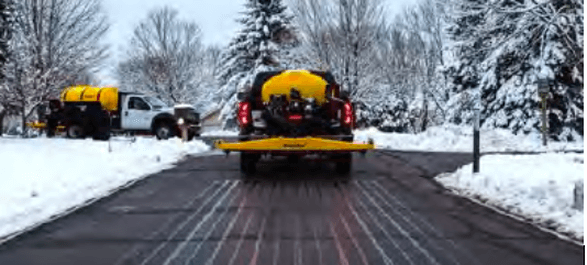Brine: The Unsung Hero of Winter Roads
🧊 Brine: The Unsung Hero of Winter Roads
Picture a freezing morning. Your car slides even before the engine starts. That's the sort of danger local crews fight every winter—often using little more than salty hot water, aka brine.
🧂 Why Salt in Water Works Better Than Dry Salt
If you've sprinkled salt on icy sidewalks, you know you need snow or water first before it works. Brine skips that step. Think of it as salt already dissolved into warm water—that way, it gets right down to melting.
At about 23% salt, brine can prevent ice from forming down to around 18 °F (–8 °C). That means crews can spray it before a storm hits. No waiting for melting—it forms a thin layer that stops ice from bonding to pavement. Less work, less delay, less snow buildup.
🚛 Proactive vs. Reactive
Brine (anti‑icing): sprayed ahead of storms. Works fast. Cuts down the amount of salt needed afterward by up to 70%.
Dry salt (de‑icing): scattered after ice forms. It only works when it dissolves—so it's slower and often wasted.
🌱 Environment vs. Efficiency
Salt isn't just slick—it's kind of brutal on nature:
- It raises chloride levels in lakes and streams, sometimes 20–30× above safe limits
- It damages soil and roadside plants, harming microbes and weakening root systems
- It corrodes concrete, bridges, and vehicle parts, causing billions in repairs annually
Brine, though still salty, reduces these risks by sticking to pavement more effectively—meaning less salt washes off into the environment.
💡 Smart Moves & Community Wins
Cities like Eau Claire, WI, brewing local brine have saved ~$130,000 per winter.
U.S. towns are testing organic brines: beet-juice, cheese-whey, even pickle liquid. These help reduce salt use but come with quirks—like odor or sugar runoff.
Education programs (like "smart salting") train crews to apply just enough—Minnesota cut salt use by 30–70% thanks to these.
🛠️ A Balanced Playbook
- Pre‑storm brining: hit roads early with brine to block ice before it starts.
- Targeted dry salt: use sparingly and only when needed.
- Consider organics: mix in food-based additives where viable.
- Staff training: emphasize proper dosage and timing.
- Monitor ecosystems: especially lakes, groundwater, and vegetation near roads.
✅ Why It Matters
Brine gives us a fighting chance against icy roads—fast, efficient, and with a far lower environmental footprint than dumping salt later. But it's not a silver bullet. As communities learn, tweak, and invest in smarter tools and green alternatives, we edge closer to roads that are safe to drive on and kinder to the planet.
Sources: northcastleny.com, nlc.org, mwmo.org, theconservationfoundation.org, epa.gov, pbsnc.org, stormwater.pca.state.mn.us, hilltipna.com, sensorex.com, apps.itd.idaho.gov, time.com



No comments